tire pressure CHEVROLET CAMARO 1997 4.G Owners Manual
[x] Cancel search | Manufacturer: CHEVROLET, Model Year: 1997, Model line: CAMARO, Model: CHEVROLET CAMARO 1997 4.GPages: 404, PDF Size: 20.96 MB
Page 172 of 404
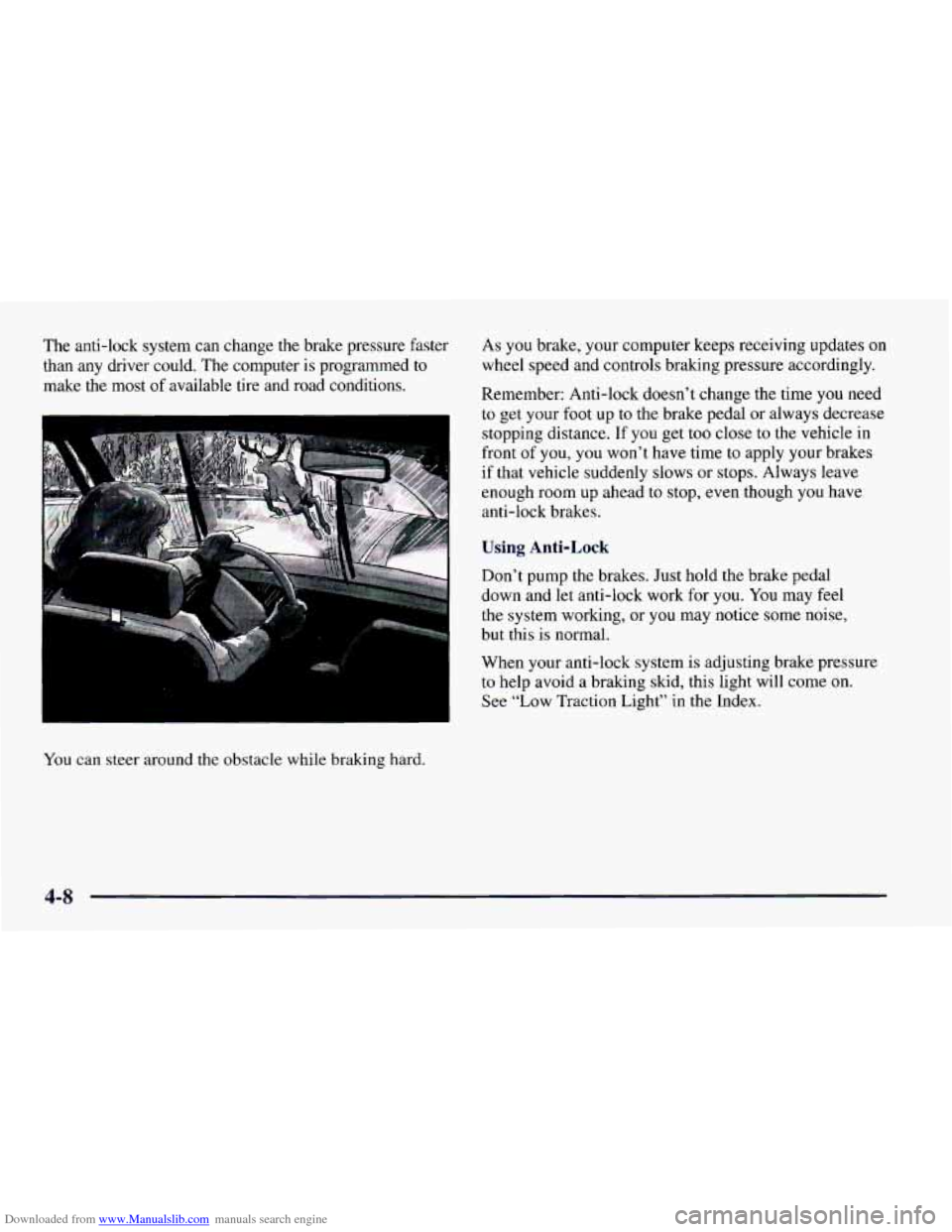
Downloaded from www.Manualslib.com manuals search engine The anti-lock system can change the brake pressure faster As you brake, your computer keeps receiving updates on
than any driver could. The computer is programmed to wheel speed and controls braking pressure accordingly.
make the most
of available tire and road conditions.
Remember: Anti-lock doesn’t change the time you need
to get your foot up to the brake pedal or always decrease
stopping distance. If you get
too close to the vehicle in
front
of you, you won’t have time to apply your brakes
if that vehicle suddenly slows or stops. Always leave
enough room up ahead to stop, even though
you have
anti-lock brakes.
You can steer around the obstacle while braking hard.
Using Anti-Lock
Don’t pump the brakes. Just hold the brake pedal
down and
let anti-lock work for you. You may feel
the system working, or you may notice some noise,
but this is normal.
When your anti-lock system
is adjusting brake pressure
to help avoid a braking skid, this light will come on.
See “Low Traction Light” in the Index.
4-8
Page 184 of 404
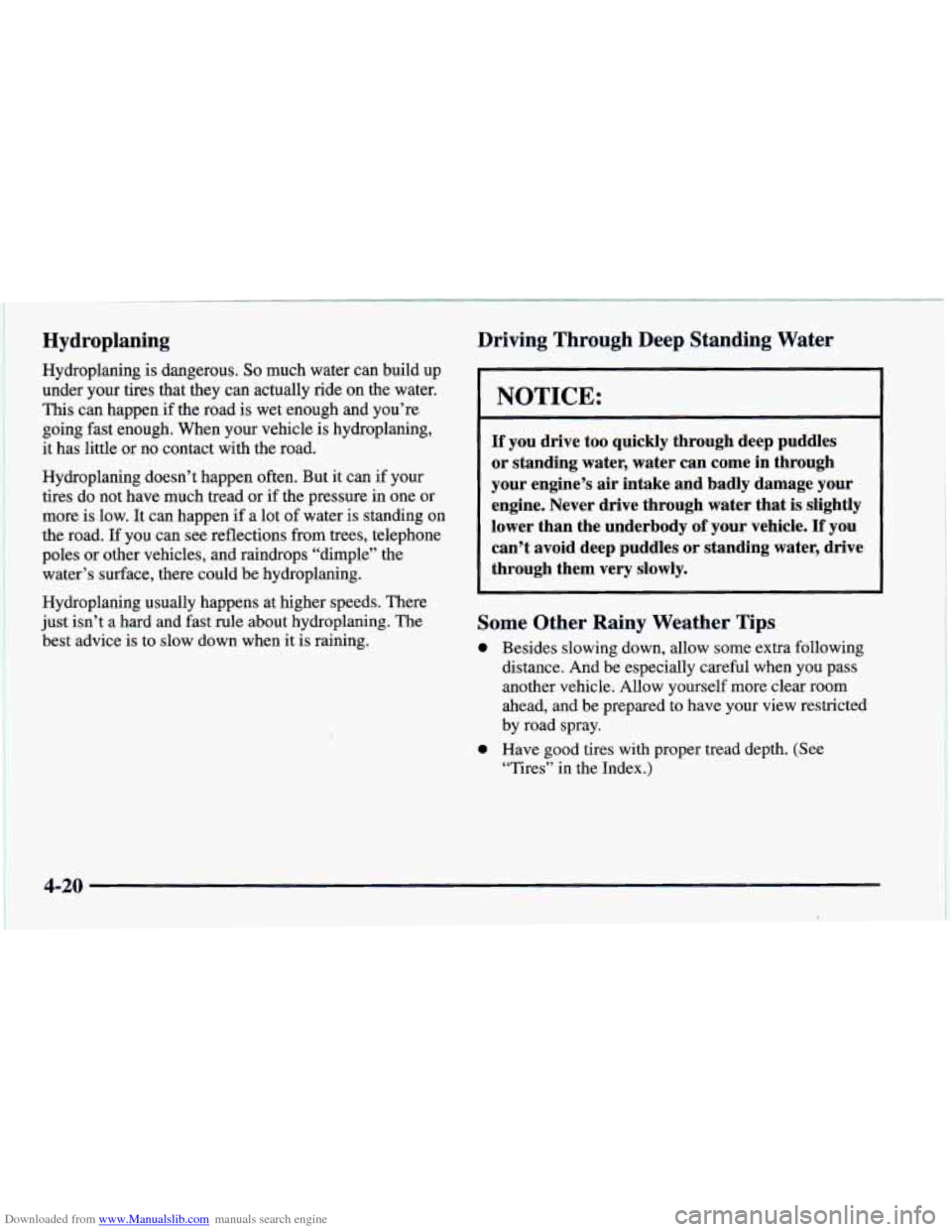
Downloaded from www.Manualslib.com manuals search engine Hydroplaning
Hydroplaning is dangerous. So much water can build up
under your tires that they can actually ride on the water.
This can happen if the road is wet enough and you’re
going fast enough. When your vehicle is hydroplaning,
it has little or no contact with the road.
Hydroplaning doesn’t happen often. But it can if your
tires do not have much tread or if the pressure in one or
more is low. It can happen if a lot of water is standing on
the road. If you can see reflections from trees, telephone
poles or other vehicles, and raindrops “dimple” the
water’s surface, there could be hydroplaning.
Hydroplaning usually happens at higher speeds. There
just isn’t a hard and fast rule about hydroplaning. The
best advice is to slow down when it is raining.
Driving Through Deep Standing Water
NOTICE:
If you drive too quickly through deep puddles
or standing water, water can come in through
your engine’s air intake and badly damage your
engine. Never drive through water that
is slightly
lower than the underbody
of your vehicle. If you
can’t avoid deep puddles or standing water, drive
through them very slowly.
Some Other Rainy Weather Tips
0 Besides slowing down, allow some extra following
distance. And be especially careful when you pass
another vehicle. Allow yourself more clear room
ahead, and be prepared to have your view restricted
by road spray.
“Tires” in the Index.)
0 Have good tires with proper tread depth. (See
4-20
Page 187 of 404
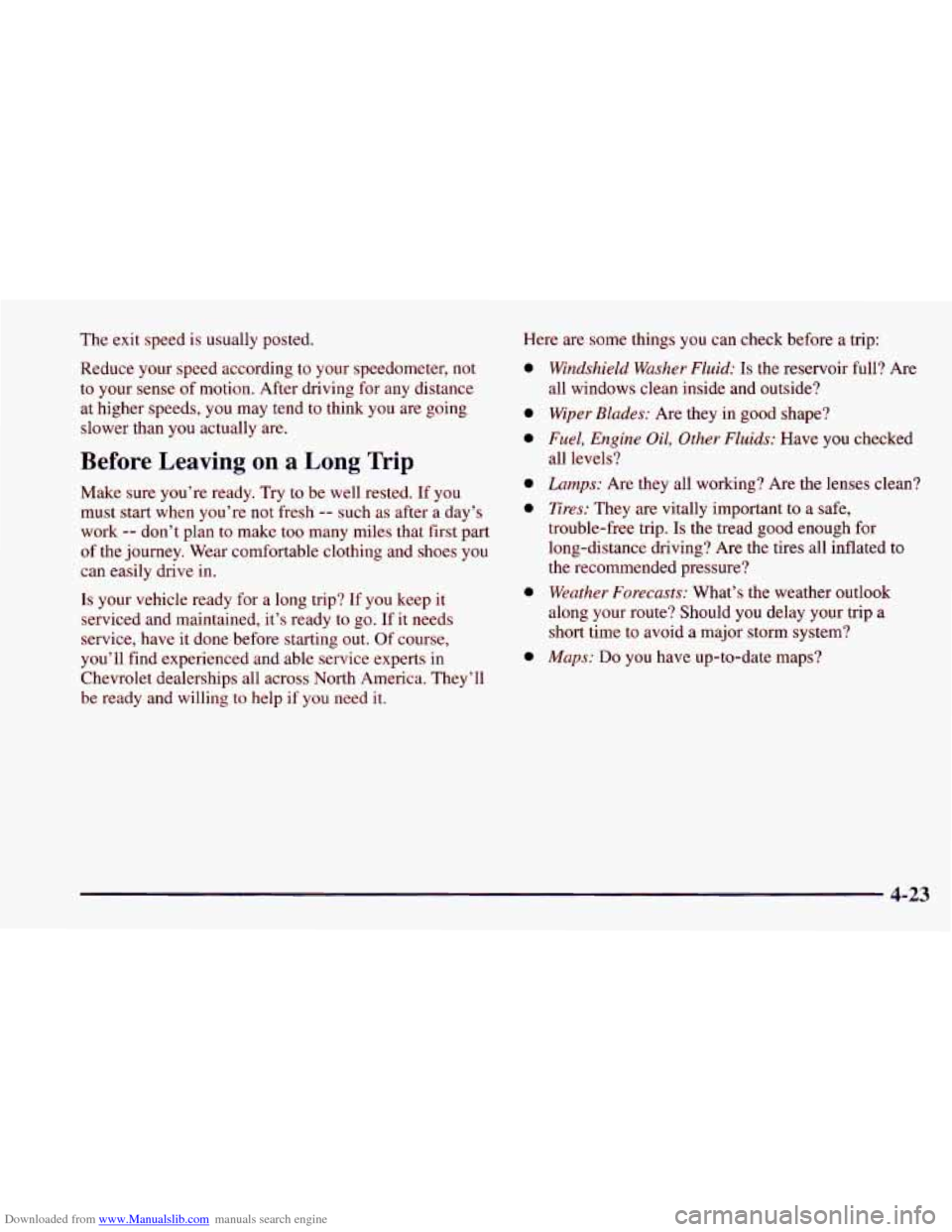
Downloaded from www.Manualslib.com manuals search engine The exit speed is usually posted.
Reduce your speed according to your speedometer, not
to your sense
of motion. After driving for any distance
at higher speeds, you may tend to think you are going
slower than you actually are.
Before Leaving on a Long Trip
Make sure you’re ready. Try to be well rested. If you
must start when you’re not fresh
-- such as after a day’s
work
-- don’t plan to make too many miles that first part
of the journey. Wear comfortable clothing and shoes you
can easily drive in.
Is your vehicle ready for a long trip? If you keep it
serviced and maintained, it’s ready to go. If it needs
service, have it done before starting out.
Of course,
you’ll find experienced and able service experts in
Chevrolet dealerships all across North America. They’ll
be ready and willing to help if you need it. Here
are some things you can check before a trip:
0
0
0
0
0
0
0
Windshield Washer Fluid: Is the reservoir full? Are
all windows clean inside and outside?
Wiper Blades: Are they in good shape?
Fuel, Engine Oil, Other Fluids: Have you checked
all levels?
Lamps: Are they all working? Are the lenses clean?
Tires: They are vitally important to a safe,
trouble-free trip. Is the tread good enough for
long-distance driving? Are the tires all inflated to
the recommended pressure?
Weather Forecasts: What’s the weather outlook
along your route? Should you delay your trip a short time to avoid a major storm system?
Maps: Do you have up-to-date maps?
4-23
Page 194 of 404
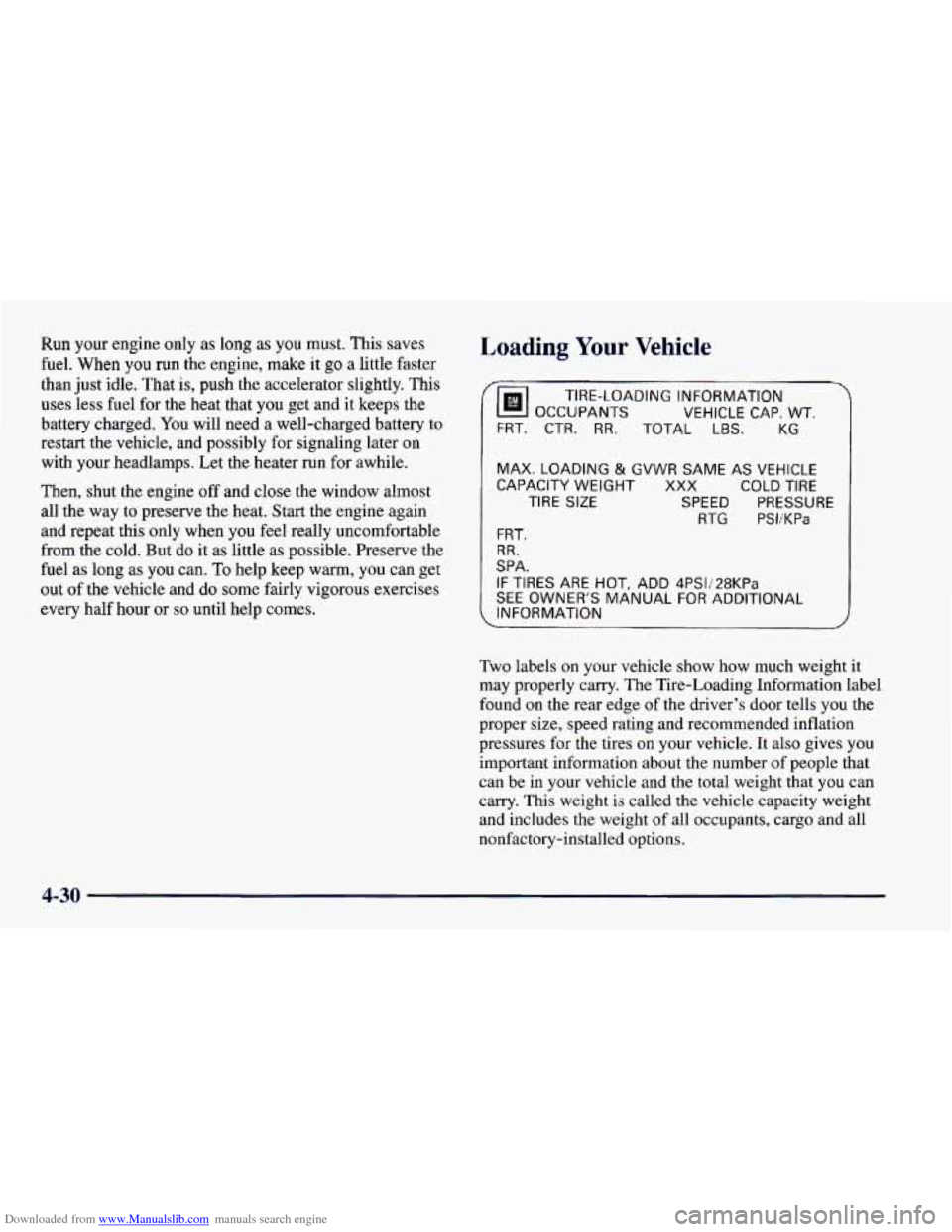
Downloaded from www.Manualslib.com manuals search engine Run your engine only as long as you must. This saves
fuel.
When you run the engine, make it go a little faster
than just idle. That
is, push the accelerator slightly. This
uses less fuel for the heat that you get and it keeps the
battery charged. You will need
a well-charged battery to
restart the vehicle, and possibly for signaling later on
with your headlamps. Let the heater run for awhile.
Then, shut the engine
off and close the window almost
all the way to preserve the heat. Start the engine again
and repeat this only when
you feel really uncomfortable
from the cold. But do it as little
as possible. Preserve the
fuel
as long as you can. To help keep warm, you can get
out
of the vehicle and do some fairly vigorous exercises
every half hour or
so until help comes.
Loading Your Vehicle
i"
.
TIRE-LOADING INFORMATION
OCCUPANTS VEHICLE CAP.
WT.
FRT. CTR. RR. TOTAL LBS. KG
MAX. LOADING
& GVWR SAME AS VEHICLE
CAPACITY WEIGHT
XXX COLD TIRE
TIRE SIZE SPEED PRESSURE
RTG PSUKPa
FRT.
RR.
SPA.
IF TIRES ARE HOT, ADD 4PS1/28KPa
SEE OWNER'S MANUAL FOR ADDITIONAL
, INFORMATION
Two labels on your vehicle show how much weight it
may properly carry. The Tire-Loading Information label
found on the rear edge
of the driver's door tells you the
proper size, speed rating and recommended inflation
pressures for the tires on your vehicle. It also gives you
important information about the number of people that
can be in your vehicle and the total weight that you can
carry. This weight is called the vehicle capacity weight
and includes the weight of all occupants, cargo and all
nonfactory-installed options.
4-30
Page 244 of 404
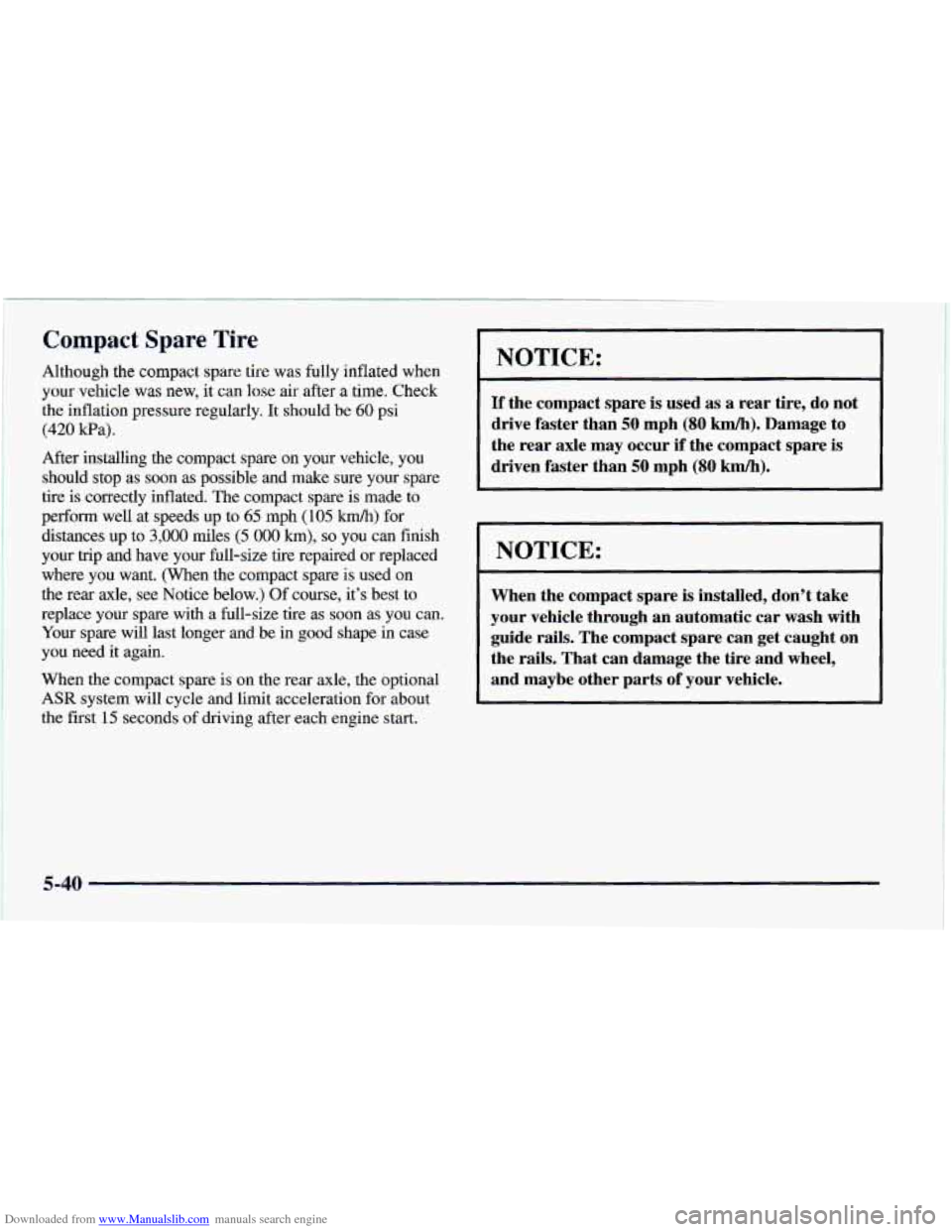
Downloaded from www.Manualslib.com manuals search engine Compact Spare Tire
Although the compact spare tire was fully inflated when
your vehicle was new, it can
lose air after a time. Check
the inflation pressure regularly. It should
be 60 psi
(420 Ea).
After installing the compact spare on your vehicle, you
should stop as soon as possible and make sure your spare
tire
is correctly inflated. The compact spare is made to
perform well at speeds up to 65 mph (105 km/h) for
distances up to
3,000 miles (5 000 km), so you can finish
your trip and have your full-size tire repaired or replaced
where
you want. (When the compact spare is used on
the rear axle, see Notice below.) Of course, it’s best to
replace your spare
with a full-size tire as soon as you can.
Your spare will last longer and be in good shape in case
you need it again.
When the compact spare
is on the rear axle, the optional
ASR system will cycle and limit acceleration for about
the first
15 seconds of driving after each engine start.
I I
NOTICE:
If the compact spare is used as a rear tire, do not
drive faster than 50 mph (80 km/h). Damage to
the rear axle may occur
if the compact spare is
driven faster than 50 mph (80 W).
NOTICE:
When the compact spare is installed, don’t take
your vehicle through an automatic car wash with
guide rails. The compact spare can get caught on
the rails. That can damage the tire and wheel,
and maybe other parts
of your vehicle.
5-40
Page 287 of 404
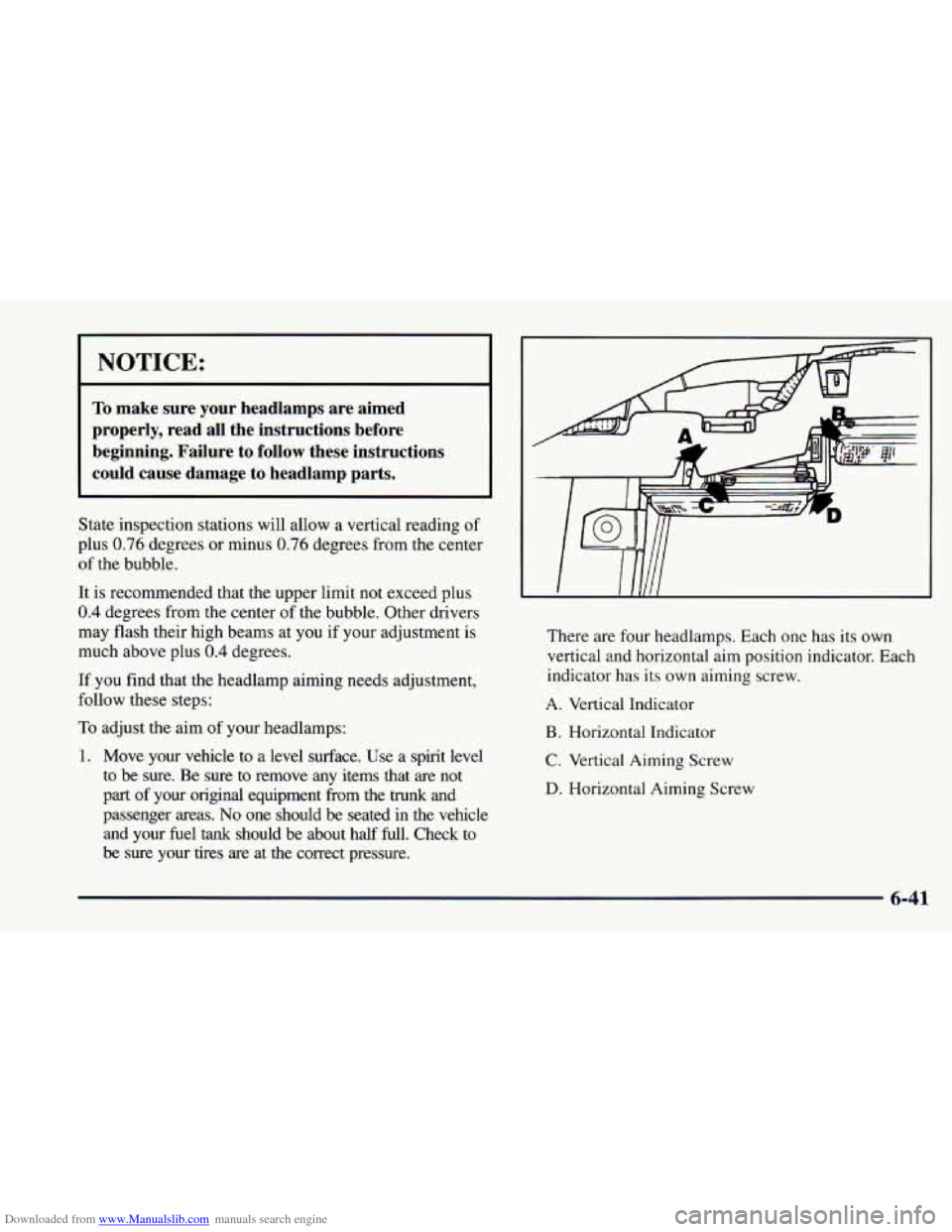
Downloaded from www.Manualslib.com manuals search engine I NOTICE:
To make sure your headlamps are aimed
properly, read all the instructions before
beginning. Failure to follow these instructions
could cause damage
to headlamp parts.
State inspection stations will allow a vertical reading of
plus 0.76 degrees or minus 0.76 degrees from the center
of the bubble.
It
is recommended that the upper limit not exceed plus
0.4 degrees from the center of the bubble. Other drivers
may flash their high beams at
you if your adjustment is
much above plus
0.4 degrees.
If you find that the headlamp aiming needs adjustment,
follow these steps:
To adjust the aim of your headlamps:
1. Move your vehicle to a level surface. Use a spirit level
to be sure. Be sure to remove any items that
are not
part of your original equipment from the trunk and
passenger areas. No one should be seated in the vehicle
and
your fuel tank should be about half full. Check to
be sure your tires are at the correct pressure. There are four
headlamps. Each one has its own
vertical and horizontal aim position indicator. Each
indicator has its own aiming screw.
A. Vertical Indicator
B. Horizontal Indicator
C. Vertical Aiming Screw
D. Horizontal Aiming Screw
6-41
Page 296 of 404
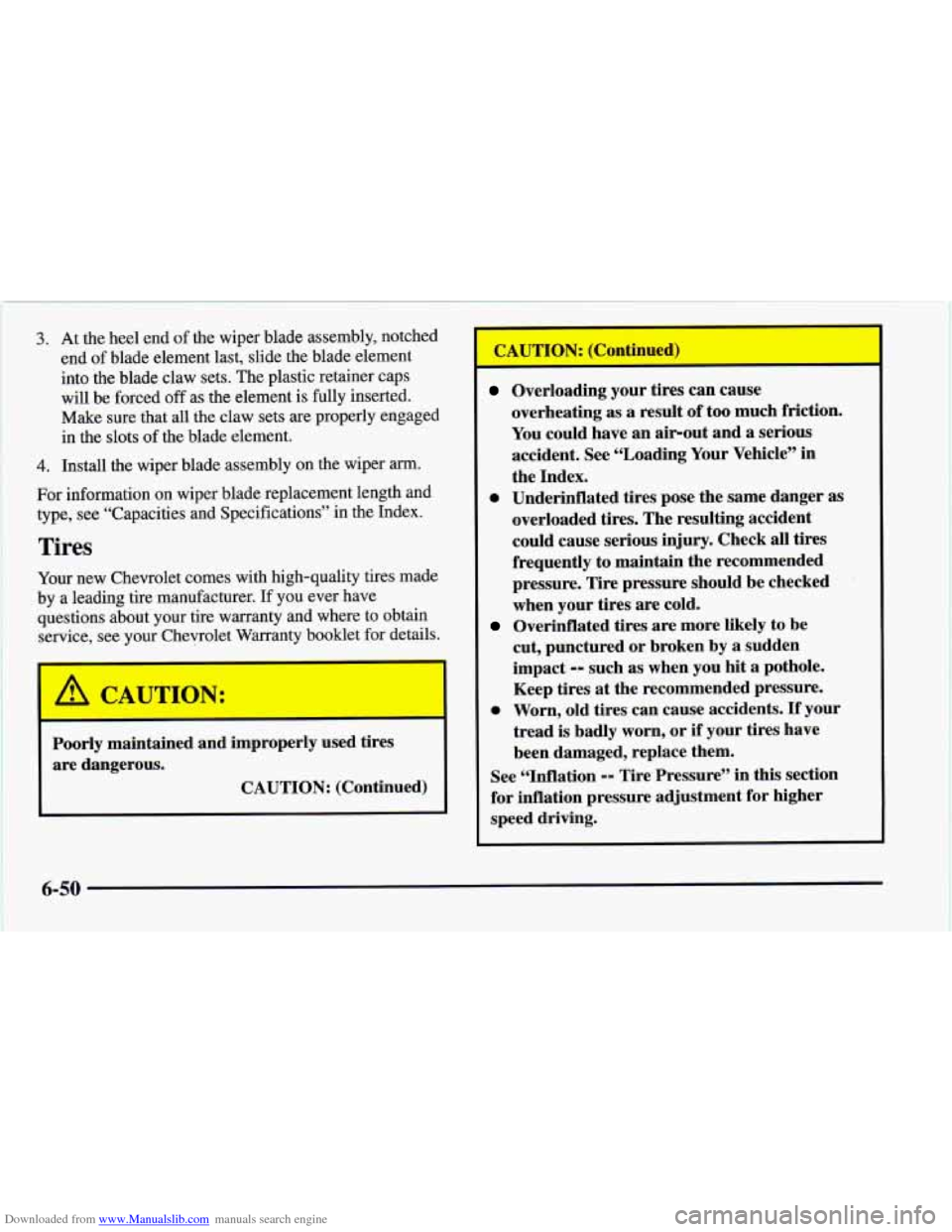
Downloaded from www.Manualslib.com manuals search engine ~ 3. At
the heel end of the wiper blade assembly, notched
end of blade element last, slide the blade element
into the blade claw sets. The plastic retainer caps
will be forced
off as the element is fully inserted.
Make sure that all the claw sets are properly engaged
in the slots of the blade element.
4. Install the wiper blade assembly on the wiper arm.
For information on wiper blade replacement length and
type, see “Capacities and Specifications” in the Index.
Tires
Your new Chevrolet comes with high-quality tires made
by a leading tire manufacturer. If you ever have
questions about your tire warranty and where to obtain
service, see your Chevrolet Warranty booklet for details.
Poorly maintained and improperly used tires
are dangerous.
CAUTION: (Continued)
Overloading your tires can cause
overheating as
a result of too much friction.
You could have an air-out and a serious
accident. See “Loading Your Vehicle” in
the Index.
0 Underinflated tires pose the same danger as
overloaded tires. The resulting accident
could cause serious injury. Check all tires
frequently to maintain the recommended
pressure. Tire pressure should be checked
when your tires are cold.
cut, punctured or broken
by a sudden
impact
-- such as when you hit a pothole.
Keep tires at the recommended pressure.
0 Worn, old tires can cause accidents. If your
tread
is badly worn, or if your tires have
been damaged, replace them.
See “Inflation
-- Tire Pressure’’ in this section
for inflation pressure adjustment for higher
speed driving.
Overinflated tires are more likely to be
6-50
Page 297 of 404
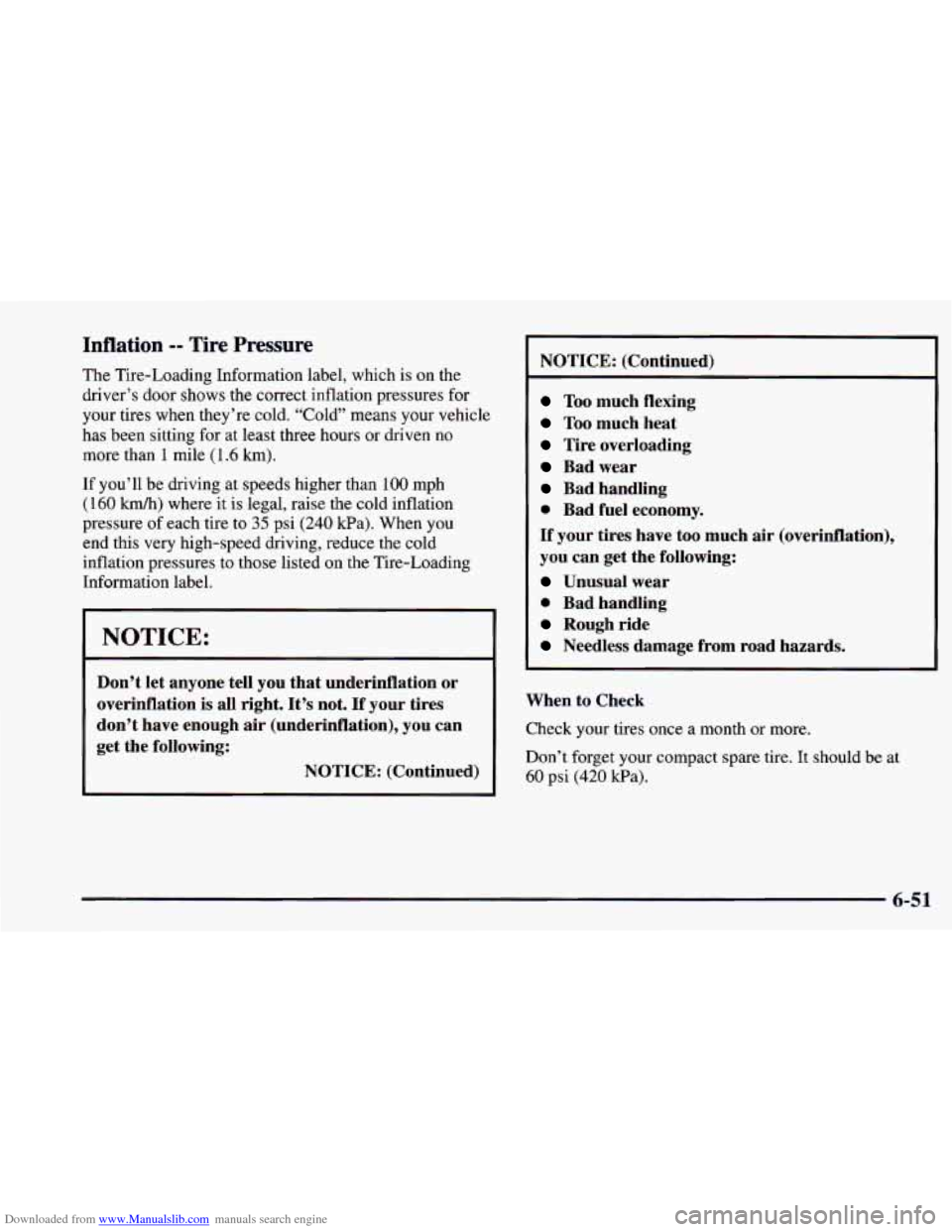
Downloaded from www.Manualslib.com manuals search engine Inflation -- Tire Pressure
The Tire-Loading Information label, which is on the
driver’s door shows the correct inflation pressures
for
your tires when they’re cold. “Cold” means your vehicle
has been sitting for
at least three hours or driven no
more than 1 mile
(1.6 km).
If you’ll be driving at speeds higher than 100 mph
(160 km/h) where it is legal, raise the cold inflation
pressure
of each tire to 35 psi (240 kPa). When you
end this very high-speed driving, reduce the cold
inflation pressures to those listed on the Tire-Loading
Information label.
NOTICE:
Don’t let anyone tell you that underinflation or
overinflation is all right.
It’s not. If your tires
don’t have enough air (underinflation), you can
get the following:
NOTICE: (Continued) NOTICE:
(Continued)
Too much flexing
Too much heat
Tire overloading
Bad wear
Bad handling
0 Bad fuel economy.
If your tires have too much air (overinflation),
you can get the following:
Unusual wear
0 Bad handling
Rough ride
Needless damage from road hazards.
When to Check
Check your tires once a month or more.
Don’t forget your compact spare tire. It should be at
60 psi (420 kPa).
6-51
Page 298 of 404
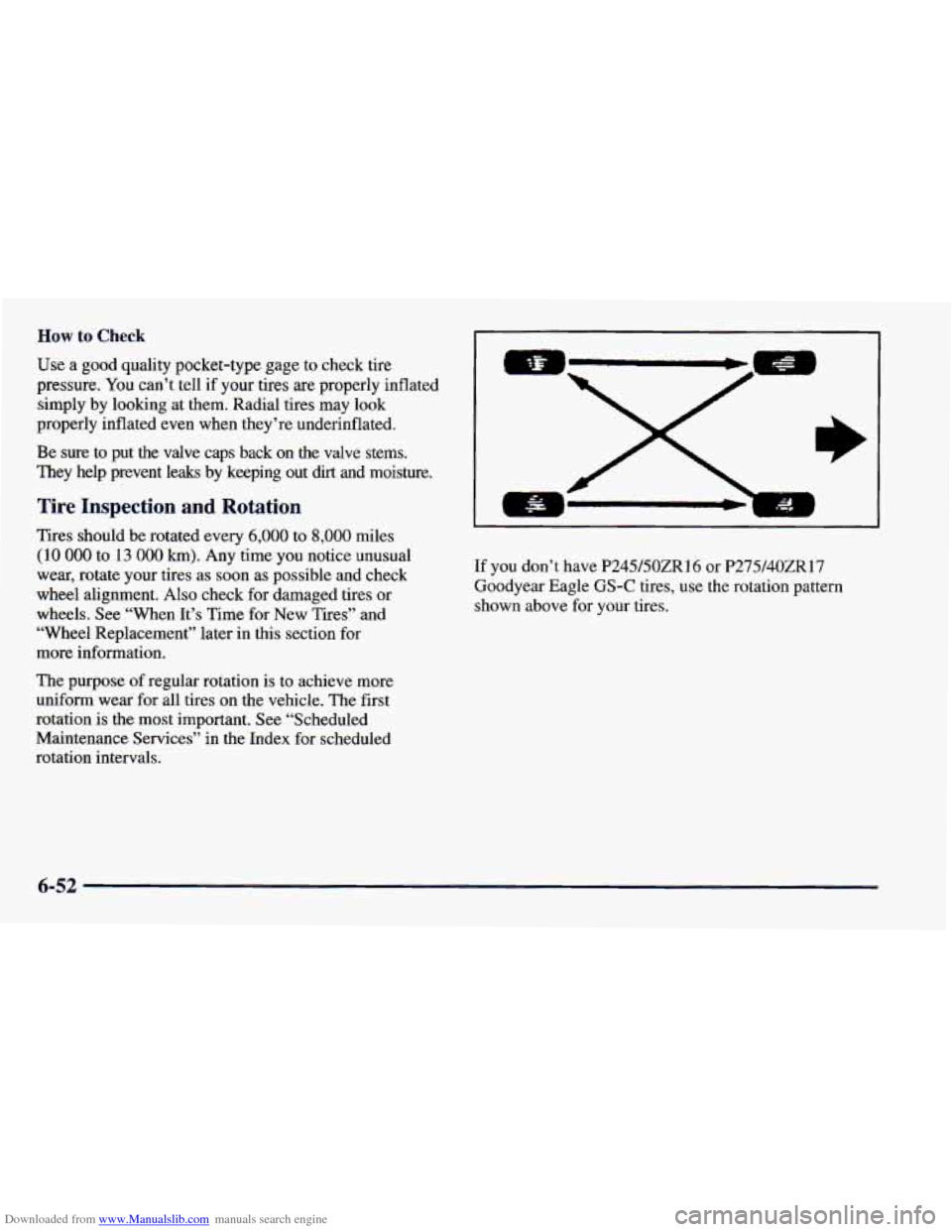
Downloaded from www.Manualslib.com manuals search engine How to Check
Use a good quality pocket-type gage to check tire
pressure. You can’t tell if your tires are properly inflated
simply by looking at them. Radial tires may look
properly inflated even when they’re underinflated.
Be sure to put
the valve caps back on the valve stems.
They help prevent leaks by keeping out dirt and moisture.
Tire Inspection and Rotation
Tires should be rotated every 6,000 to 8,000 miles
(10
000 to 13 000 km). Any time you notice unusual
wear, rotate your tires as soon as possible and check
wheel alignment.
Also check for damaged tires or
wheels. See “When It’s Time for New Tires” and
“Wheel Replacement” later in this section for
more information.
The purpose of regular rotation is
to achieve more
uniform wear for all tires on the vehicle. The first
rotation is the most important. See “Scheduled
Maintenance Services” in the Index for scheduled
rotation intervals.
c-
If you don’t have P245/5OZR16 or P275/40ZR17
Goodyear Eagle GS-C tires, use the rotation pattern
shown above for your tires.
6-52
Page 299 of 404
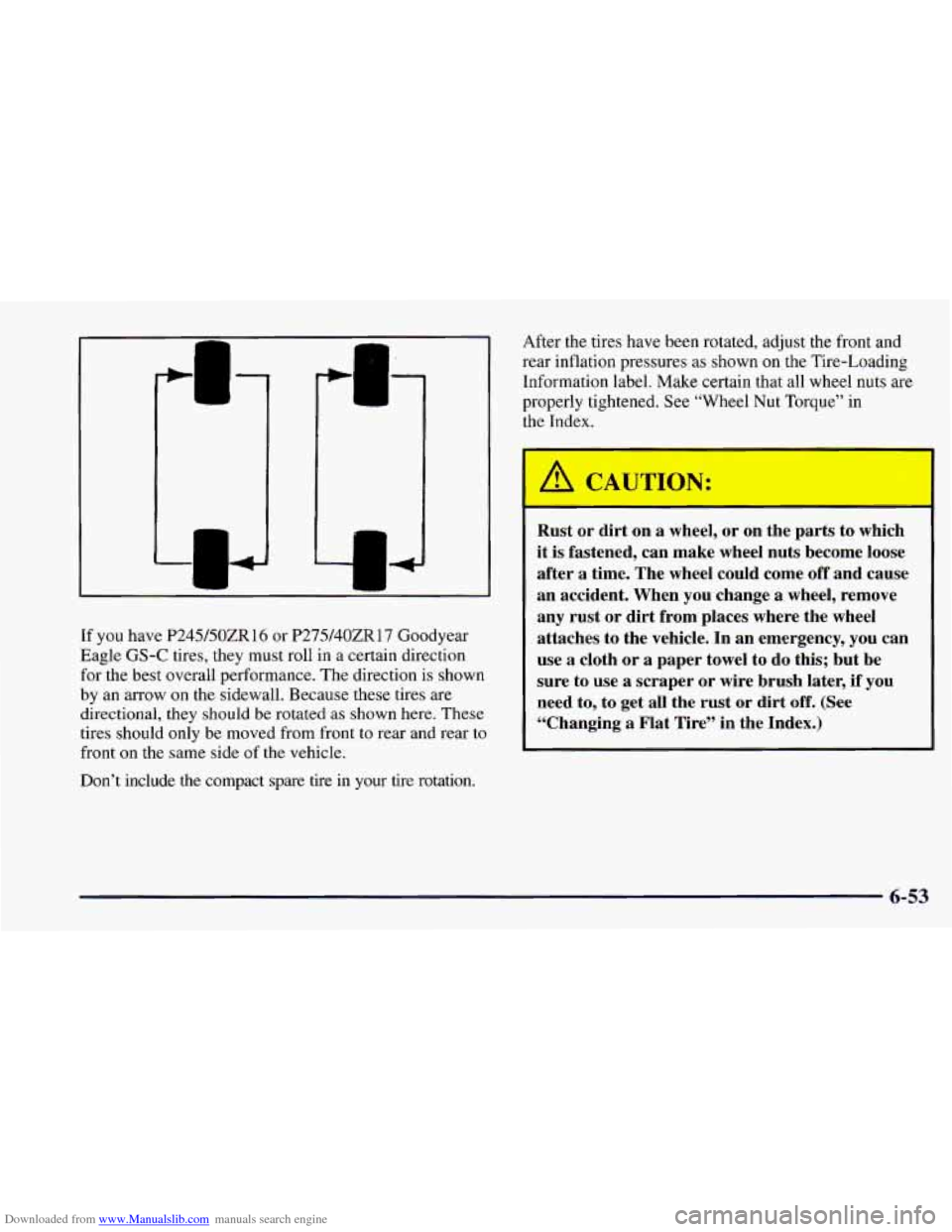
Downloaded from www.Manualslib.com manuals search engine L
If you have P245/50ZR 16 or P275/40ZR17 Goodyear
Eagle GS-C tires, they must roll in a certain direction
for the best overall performance. The direction is shown
by an arrow
on the sidewall. Because these tires are
directional, they
should be rotated as shown here. These
tires should
only be moved from front to rear and rear to
front on the same side of the vehicle.
Don’t include the compact spare tire in your tire rotation. After the tires have been rotated,
adjust the front and
rear inflation pressures as shown
on the Tire-Loading
Information label. Make certain that all wheel
nuts are
properly tightened.
See “Wheel Nut Torque” in
the Index.
Rust or dirt on a wheel, or on the parts to which
it is fastened, can make wheel nuts become loose
after a time. The wheel could come
off and cause
an accident. When you change a wheel, remove
any rust or dirt from places where the wheel
attaches to the vehicle. In an emergency, you can
use a cloth or a paper towel to do this; but be
sure to use
a scraper or wire brush later, if you
need to, to get all
the rust or dirt off. (See
“Changing
a Flat Tire” in the Index.)
6-53